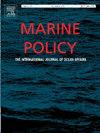Characterization of the for-hire fishery in the U.S. South Atlantic and regional policy implications
IF 3.7
2区 社会学
Q2 ENVIRONMENTAL STUDIES
引用次数: 0
Abstract
Worldwide, recreational fisheries are of growing social and economic importance and recreational landings even exceed the commercial sector in some locations within the United States. However, there are continuing challenges to managing recreational fisheries, with respect to monitoring recreational participation and catch as well as satisfying a heterogeneous angler population and diverse management objectives. The southeastern U.S. is an epicenter for recreational fishing and is a transitional ecosystem, extending from subtropical Florida waters to the more temperate North Carolina ecosystems. Using participatory methods to gain insights from local knowledge, combined with data from standardized recreational monitoring programs and social media photos, we describe the dynamics of the for-hire fleet across the region with a particular emphasis on Dolphinfish (Coryphaena hippurus), a species of primary importance. We describe the landings composition, reliance of the fishery on different species based on their seasonal availability, and analyze how this varies across regions. Trends from a social media analysis are consistent with existing recreational monitoring programs and support the perspectives of fishermen gathered during a series of workshops. We show significant differences between landings characteristics in Florida versus North Carolina and Virginia, which underscores the need for subregional considerations when implementing management regulations across the jurisdictional scale. We also describe how our methods could be used to inform species landings associations and potential effort shifts, provide early warning signals for range shift or other changes in the fishery, and give insights relevant to innovation in recreational fisheries management.
美国南大西洋出租渔业的特点及其对区域政策的影响
在世界范围内,休闲渔业的社会和经济重要性日益增加,在美国的一些地方,休闲捕鱼甚至超过了商业捕鱼。然而,管理休闲渔业仍然存在挑战,包括监测休闲参与和捕捞,以及满足不同种类的垂钓者和不同的管理目标。美国东南部是休闲钓鱼的中心,是一个过渡生态系统,从亚热带的佛罗里达水域延伸到更温和的北卡罗来纳生态系统。采用参与式方法从当地知识中获得见解,结合标准化娱乐监测项目和社交媒体照片的数据,我们描述了整个地区的租用船队的动态,特别强调了海豚(Coryphaena hippurus),这是一种重要的物种。我们描述了登陆组成,渔业对不同物种季节性可用性的依赖,并分析了这在不同地区的变化。来自社交媒体分析的趋势与现有的娱乐监测项目一致,并支持在一系列研讨会上聚集的渔民的观点。我们展示了佛罗里达州与北卡罗来纳州和弗吉尼亚州的着陆特征之间的显著差异,这强调了在整个管辖范围内实施管理法规时需要考虑分区域因素。我们还描述了如何使用我们的方法来通知物种登陆关联和潜在的努力转移,为范围转移或渔业的其他变化提供早期预警信号,并提供与休闲渔业管理创新相关的见解。
本文章由计算机程序翻译,如有差异,请以英文原文为准。
求助全文
约1分钟内获得全文
求助全文
来源期刊

Marine Policy
Multiple-
CiteScore
7.60
自引率
13.20%
发文量
428
期刊介绍:
Marine Policy is the leading journal of ocean policy studies. It offers researchers, analysts and policy makers a unique combination of analyses in the principal social science disciplines relevant to the formulation of marine policy. Major articles are contributed by specialists in marine affairs, including marine economists and marine resource managers, political scientists, marine scientists, international lawyers, geographers and anthropologists. Drawing on their expertise and research, the journal covers: international, regional and national marine policies; institutional arrangements for the management and regulation of marine activities, including fisheries and shipping; conflict resolution; marine pollution and environment; conservation and use of marine resources. Regular features of Marine Policy include research reports, conference reports and reports on current developments to keep readers up-to-date with the latest developments and research in ocean affairs.
 求助内容:
求助内容: 应助结果提醒方式:
应助结果提醒方式:


